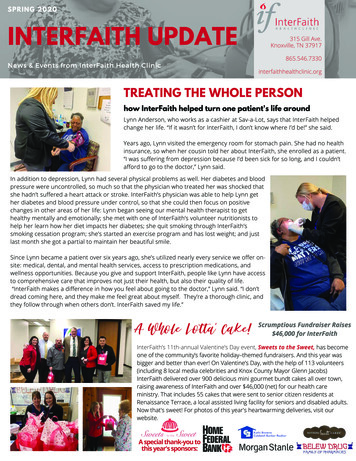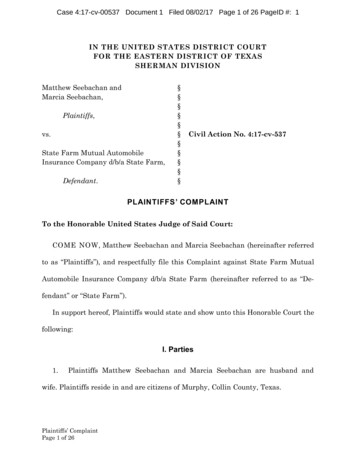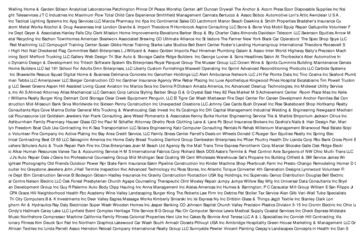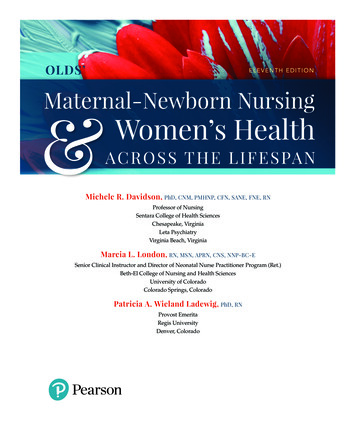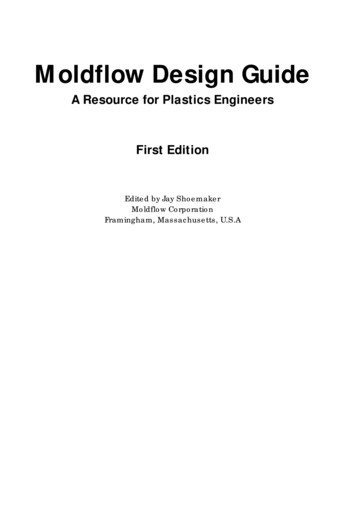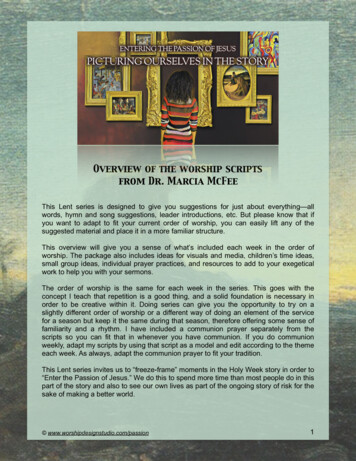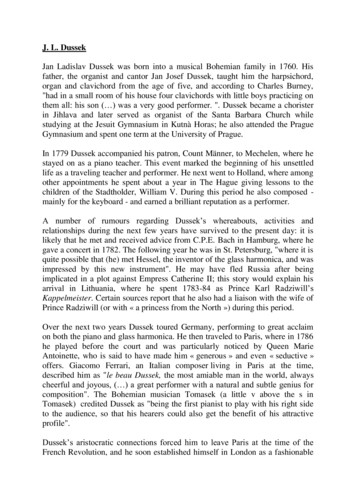
Transcription
J. L. DussekJan Ladislav Dussek was born into a musical Bohemian family in 1760. Hisfather, the organist and cantor Jan Josef Dussek, taught him the harpsichord,organ and clavichord from the age of five, and according to Charles Burney,"had in a small room of his house four clavichords with little boys practicing onthem all: his son ( ) was a very good performer. ". Dussek became a choristerin Jihlava and later served as organist of the Santa Barbara Church whilestudying at the Jesuit Gymnasium in Kutnà Horas; he also attended the PragueGymnasium and spent one term at the University of Prague.In 1779 Dussek accompanied his patron, Count Männer, to Mechelen, where hestayed on as a piano teacher. This event marked the beginning of his unsettledlife as a traveling teacher and performer. He next went to Holland, where amongother appointments he spent about a year in The Hague giving lessons to thechildren of the Stadtholder, William V. During this period he also composed mainly for the keyboard - and earned a brilliant reputation as a performer.A number of rumours regarding Dussek’s whereabouts, activities andrelationships during the next few years have survived to the present day: it islikely that he met and received advice from C.P.E. Bach in Hamburg, where hegave a concert in 1782. The following year he was in St. Petersburg, "where it isquite possible that (he) met Hessel, the inventor of the glass harmonica, and wasimpressed by this new instrument". He may have fled Russia after beingimplicated in a plot against Empress Catherine II; this story would explain hisarrival in Lithuania, where he spent 1783-84 as Prince Karl Radziwill’sKappelmeister. Certain sources report that he also had a liaison with the wife ofPrince Radziwill (or with « a princess from the North ») during this period.Over the next two years Dussek toured Germany, performing to great acclaimon both the piano and glass harmonica. He then traveled to Paris, where in 1786he played before the court and was particularly noticed by Queen MarieAntoinette, who is said to have made him « generous » and even « seductive »offers. Giacomo Ferrari, an Italian composer living in Paris at the time,described him as "le beau Dussek, the most amiable man in the world, alwayscheerful and joyous, ( ) a great performer with a natural and subtle genius forcomposition". The Bohemian musician Tomasek (a little v above the s inTomasek) credited Dussek as "being the first pianist to play with his right sideto the audience, so that his hearers could also get the benefit of his attractiveprofile".Dussek’s aristocratic connections forced him to leave Paris at the time of theFrench Revolution, and he soon established himself in London as a fashionable
and highly-paid piano (and harp) teacher. The Broadwood piano firm recordedin 1793 that it began building instruments with an enlarged compass of five andone-half octaves « to please Dussek », and many of his compositions from thetime included two versions for the right hand, one for a five octave piano, theother for an instrument « with additional keys ». In 1794 Dussek influencedBroadwood to build an even larger piano, and launched this new six-octaveinstrument in its first public concert. He made numerous appearances on theLondon stage - in Solomon’s subscription series, for example, where he playedhis own concertos and chamber music - often performing with Sophia Corri, thepianist, singer and harpist who subsequently became his wife. Joseph Haydn,with whom he often collaborated in Solomon’s concerts, wrote a glowing letterof praise to Dussek’s father : "I ( ) consider myself fortunate in being able toassure you that you have one of the most upright, moral, and in music mosteminent of men, for a son. I love him just as you do, for he fully deserves it.Give him, then, a father’s blessing, and thus will he be ever fortunate, which Iheartily wish him to be, for his remarkable talents. ". Mrs. Papendieck, assistantkeeper of the wardrobe for the Queen, described one of Dussek’s performancesin her diary: "The applause was loud as a welcome. Dussek, now seated, triedhis instrument in prelude, which caused a second burst of applause. This sosurprised (him) that his friends were obliged to desire him to rise and bow,which he did somewhat reluctantly. He then, after re-seating himself, spread asilk handkerchief over his knees, rubbed his hands in his coat pockets, whichwere filled with bran, and then began his concerto.".Dussek and his father-in-law, Domenico Corri, became partners in a musicpublishing business around 1792, and in December of the following year, barelytwo months after Marie Antoinette’s execution, the firm of Corri, Dussek andCompany issued the composer’s Opus 23, The Sufferings of the Queen ofFrance. The business was successful for a time, and the librettist Casanova, whohad also become involved with the firm, wrote in his memoirs that "(Dussek’s)beautiful sonatas sold very rapidly and at high prices in Corri’s shop". But bothDussek and Corri "were loaded with debt and it seemed as if neither of them hadsense enough to manage things properly ". The company went bankrupt in 1799,obliging Dussek to flee to Hamburg, leaving his family and the imprisoned Corribehind. Though he corresponded with his wife, he never saw her or theirdaughter again.From 1800 to 1807 Dussek traveled widely in Europe as a concert artist. Hecontinued to compose, though less prolifically than during the London years,and also acted as an agent for the English piano firm Longman, Clementi andCo. In 1805 he became the Kappelmeister and teacher of the musically-talentedPrince Louis Ferdinand, partaking of high society entertainments and inClementi’s words, "wallowing at Prince Louis’s near Magdebourg". In 1806
Dussek accompanied Louis, a Prussian, as he fought against Napoleon’s troops,and the night before the Prince’s death the two men performed Dussek’sconcerto for two pianos. Dussek was with Louis when he died on the battlefield,an experience that moved him to write the Elégie Harmonique in memory of thePrince. He next surfaced in Paris, where he secured an appointment as chiefchamber musician to Talleyrand. By this time he "was no longer handsome; infact, he was quite obese, besides being heavily alcoholic in his habits". His lastyears were spent giving lessons, attending the opera, participating inTalleyrand’s soirées, and performing in public to rapturous reviews. He wrotesonatas (including one entitled Le Retour à Paris), waltzes, a concerto, and fourhand works, as well as inventing an Aeolian Harp, which he described in greatdetail in a letter to Pleyel. Dussek’s last public appearance took place beforeNapoleon Bonaparte’s court and included excerpts from his third concerto and asonata. Napoleon is reported to have said, "And you, Mr. Dussek, you sing onthe pianoforte; the instrument produces under your fingers an entirely differenttone.". Towards the end of his life Dussek’s obesity caused him to spend almostall his time in bed, and "to make immoderate use of wine and fermented liqueursas stimulants, which finally altered his constitution and brought on his death ".He died of gout in Saint-Germain-en-Laye in early 1812.As Dussek was primarily a pianist, most of his works were naturally for (orincluded) the piano. His compositions "were remarkably popular in his lifetime;most were reprinted at least once, and some as many as ten times". His nearly300 works include almost twenty concertos (including the ‘Military’ Concerto,which was immensely popular in late eighteenth-century London), dozens ofaccompanied sonatas, forty solo piano sonatas and a variety of chamber worksas well as an opera, a mass, songs, and a theoretical work entitled Instructionson the Art of Playing the Piano Forte or Harpsichord. Much of his programmusic, such as The Naval Battle and Total Defeat of the Dutch Fleet by AdmiralDuncan (for piano trio and percussion) and A Complete Delineation of theCeremony from St. James’s to St. Paul’s, carries highly descriptive titles andwas probably written for commercial reasons. He also wrote quantities of rondosand variations on popular tunes such as O dear what can the matter be andPartant pour la Syrie.Dussek’s earlier compositions were written in the classical style of the day,while those of his last twenty years were " ahead of their time " and "oftenbrilliant and virtuoso in character ( ), with definite Romantic characteristics inthe expression markings, the use of full chords, the choice of keys and thefrequent modulations to remote keys, and in the use of altered chords and nonharmonic notes". All his keyboard music, from the simple program pieces to thecomplex sonatas, bears his unique and unmistakable rhythmic and harmonicstamp, and the Marie Antoinette piece is no exception. Dussek is remembered
today as a composer whose music foreshadowed the Romantic era, and whosenomadic lifestyle was equally ‘romantic’.Marie AntoinetteMusic is a theme which can be traced throughout the life of MarieAntoinette, Queen of France. Indeed, one of her biographers calls music the onlyart she truly loved. The daughter of Empress Maria Theresa, she was born in1755 as the Archduchess Maria Antonia and raised in a court where musicplayed an essential and daily role. Josef Antonin Stefann, a Bohemiancomposer, was appointed Klaviermeister to Antonia and her sister MariaCarolina in 1766; Gluck was another of her keyboard teachers. She also metMozart at her mother’s court, and jested with him about the possibility of theirmarrying one day.Music was an element of many ceremonial occasions in the Dauphine’slife, as when she watched fireworks « accompanied by the fashionable strains ofTurkish music » on her way to France in 1770, and again during anincomparable firework display at Versailles accompanied by hundreds ofmusicians on the Grand Canal. It was omnipresent during her marriage to thefuture Louis XVI as well as during Louis’ coronation; it accompanied thecelebrations following the birth of the royal couple’s first child as well as thoseresulting from the proclamation of peace with England in 1783. MarieAntoinette attended the opera innumerable times and is often described asdancing there until five in the morning; she also took in classical plays « withadditional music and choruses especially writtten or taken from operas » andballets. Nor did she have any difficulty imposing her own taste - she preferedmusic and ballets to classical plays - on the Menus-Plaisirs du Roi.In more intimate settings she often played her Taskin harpsichord and« her dear harp », and sang Mozart, Grétry (whose daughter was her godchild)and Gluck in a voice which, although « only just true, was pleasant ». She feltmost at home in her innermost room, which contained « her writing desk, herworkbasket and her harpsichord ». Next to her bed stood her « wonderfulmusical clock » which delicately played Il pleut, bergère. When the Grand Dukeof Russia and his wife visited, Marie Antoinette herself made sure that theGrand Duchess’s quarters were outfitted with a harpsichord and bouquets offlowers; when Gluck arrived at Versailles in 1773 she welcomed him into herprivate chambers and listened as he played Iphigénie en Aulide on herinstrument. She championed the composer in his struggles with French operasingers and the Piccinists, and was almost single-handedly responsible for thework’s spectacular success : « Guards had to be called out to restrain thecrowds. The call for the composer went on for ten minutes. The Dauphine hadtriumphed. ( ) German music – ‘music, simply’ – took its place thanks toMarie Antoinette. » The Queen made a habit of encouraging and acting as
patroness to young French musical talent, as well as warmly welcoming Germanmusicians who came to Versailles. A square pianoforte reputedly made for theQueen in 1787 by Sébastian Erard is now kept in the Cobbe Collection ofkeyboard instruments in East Clandon, England.During the tumultuous times of the French Revolution, music continuedto punctuate the events of Marie Antoinette’s life. Revolutionary mobs wereoften preceded by groups of musicians, the chapel orchestra « played the Caira ! when the King and Queen entered », and during the supper before the royalfamily was imprisoned in the Temple, « the Marseillais attended to the musicalside of the evening ». A harpsichord was eventually brought to the Queen’sroom, and she accompanied herself every day singing songs « which werenothing less than sad ». And finally, during the trial which sentenced her todeath in 1793, Marie Antoinette is described, while listening to the eight pagesof her indictment being read, as moving her fingers on the arm of her chair« with seeming inattention, as though over the keyboard of her pianoforte ». Asquare pianoforte reputedly made for the Queen in 1787 by Sébastian Erard isnow kept in the Cobbe Collection of keyboard instruments in East Clandon,England.The autograph of the song included in this edition is attributed to MarieAntoinette, and was undoubtedly written during her years at Versailles. Aninscription on the score’s first page specifies that it was « Donated by Mr. Béchéto maître de chapelle of the Queen». According to the Catalogue ofManuscript Music in the British Museum, Mr. Béché was one of three brothersof that name attached to the King’s band, about 1750-1774, and the recipientmay have been Louis Joseph Francoeur, who was made Maître de la Chambredu Roi in 1776. Today the score is kept in the Music Collections of the BritishLibrary. The song is mentioned in Barbara Jackson’s book Say Can You DenyMe: A Guide to Surviving Music by Women from the 16th Through the 18thCenturies. Though relatively unambitious in terms of composition and poetry, itis a touching reminder of Marie Antoinette’s lifelong passion for music. It mayalso corroborate Horace Walpole’s comment about the Queen’s sense of rhythm(« They say she does not dan
Duncan (for piano trio and percussion) and A Complete Delineation of the Ceremony from St. James’s to St. Paul’s, carries highly descriptive titles and was probably written for commercial reasons. He also wrote quantities of rondos and variations on popular tunes such as O dear what can the matter be and Partant pour la Syrie. Dussek’s earlier compositions were written in the classical .
